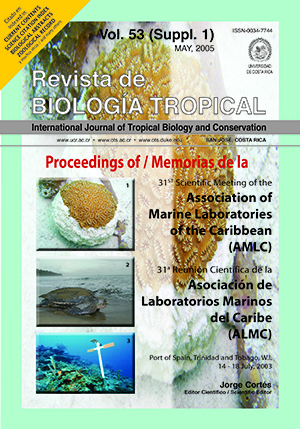Resumen
Se examina los patrones de reclutamiento de corales escleractinios zooxantelados en los Cayos de la Florida para determinar si existen diferencias en densidad o composición de la comunidad en diferentes regiones. Entre julio y setiembre del 2002, se inventariaron los reclutas (colonias de <5 cm de diámetro) usando cuadrantes y transectos al azar en nueve “parches” arrecifales: tres en los cayos del norte, tres en los del medio y tres en los del sur. Todos fueron numerados, medidos e identificados a nivel de género. Se observaron catorce géneros: entre cinco y 13 por sitio. Las densidades tuvieron un ámbito de 6.29 ± 1.92 (promedio ± DS) a 39.08 ± 4.53 reclutas m-2 , con diferencias estadísticamente significativas entre sitios y entre regiones. La densidad de reclutas en los cayos del norte fue significativamente menor que en los demás. Los cayos del norte tuvieron menor diversidad y diferente distribución de tamaños de reclutas. La mayoría de los reclutas eran de especies de escleractinios no masivas, las cuales contribuyen relativamente poco al proceso de crecimiento del arrecife, algo parecido a lo informado en otros estudios. Se encontraron menos reclutas de especies masivas en los cayos del norte. El patrón de reclutamiento en los arrecifes de los cayos del norte podría inhibir potencialmente la recuperación tras “impactos” y perturbaciones.Citas
Bak, R.P.M. & M.S. Engel. 1979. Distribution, abundance and survival of juvenile hermatypic corals (Scleractinia) and the importance of early life history strategies in the parent coral community. Mar. Biol. 54: 341-352.
Chiappone, M. & K.M. Sullivan. 1996. Distribution, abundance and species composition of juvenile scleractinian corals in the Florida reef tract. Bull. Mar. Sci. 58: 555-569.
Dunstan, P.K. & C.R. Johnson. 1998. Spatio-temporal variation in coral recruitment at different scales on Heron Reef, southern Great Barrier Reef. Coral Reefs 17: 71-81.
Dustan, P. 1977. Vitality of reef coral populations off Key Largo, Florida: Recruitment and mortality. Environ. Geol. 2: 51-58.
Dustan, P. & J.C. Halas. 1987. Changes in the reef-coral community of Carysfort Reef, Key Largo, Florida: 1974-1982. Coral Reefs 6: 91-106.
Edmunds, P.J. 2000. Patterns in the distribution of juvenile corals and coral reef community structure in St. John, US Virgin Islands. Mar. Ecol. Prog. Ser. 202: 113-124.
Edmunds, P.J., R.B. Aronson, D.W. Swanson, D.R. Levitan & W.F. Precht. 1998. Photographic versus visual census techniques for the quantification of juvenile corals. Bull. Mar. Sci. 62: 937-946.
Ginsburg, R.N. & E.A. Shinn. 1994. Preferential distribution of reefs in the Florida reef tract: The past is the key to the present, p. 21-26. In R.N. Ginsburg, Compiler. Proceedings of the colloquium on global aspects of coral reefs: Health, hazards and history, 1993. Rosenstiel School of Marine and Atmospheric Science, University of Miami, Miami.
Ginsburg, R.N., E. Gischler & W.E. Kiene. 2001. Partial mortality of massive reef-building corals: an index of patch reef condition, Florida reef tract. Bull. Mar. Sci. 69: 1149-1173.
Hughes, T.P. & J.E. Tanner. 2000. Recruitment failure, life histories, and long-term decline of Caribbean corals. Ecology 81: 2250-2263.
Lapointe, B.E. 1997. Nutrient thresholds for bottom-up control of macroalgal blooms on coral reefs in Jamaica and southeast Florida. Limnol. and Oceanogr. 42: 1119-1131.
Lapointe, B.E. & M.E. Clark. 1992. Nutrient inputs from the watershed and coastal eutrophication in the Florida Keys. Estuaries 15: 465-476.
Lessios, H.A. 1988. Mass mortality of Diadema antillarum in the Caribbean: What have we learned? Ann. Rev. Ecol. Syst. 19: 371-393.
Porter, J.W. & O.W. Meier. 1992. Quantification of loss and change in Floridian reef coral populations. Am. Zool. 32: 625-640.
Porter, J.W., V. Kosmynin, K.L. Patterson, K.G. Porter, W.C. Jaap, J.L. Wheaton, K. Hackett, M. Lybolt, C.P. Tsokos, G. Yanev, D.M. Marcinek, J. Dotten, D. Eaken, M. Patterson, O.W. Meier, M. Brill & P. Dustan. 2002. Detection of coral reef change by the Florida Keys coral reef monitoring project, p. 749-769. In J.W. Porter & K.G. Porter (eds.). The Everglades, Florida Bay, and coral reefs of the Florida Keys: An ecosystem sourcebook. CRC, Boca Raton, Florida.
Shinn, E.A., B.H. Lidz, J.L. Kindinger, J.H. Hudson & R.B. Halley. 1989. Reefs of Florida and Dry Tortugas: Field trip guidebook T176, 28th Int. Geol. Congr. Amer. Geophys. Union, Washington, DC. 53 p.
Smith, S.R. 1997. Patterns of coral settlement, recruitment and juvenile mortality with depth at Conch Reef, Florida. Proc. 8th Int. Coral Reef Symp. 2: 1197-1202.
Smith, S.V. & R.W. Buddemeier. 1992. Global change and coral reef ecosystems. Ann. Rev. Ecol. Syst. 23: 89-118.
Szmant, A.M. 1986. Reproductive ecology of Caribbean reef corals. Coral Reefs 5: 43-54.
Underwood, A.J. & M.J. Keough. 2001. Supply-side ecology: The nature and consequences of variations in recruitment of intertidal organisms, p.183-200. In M.D. Bertness, S.D. Gaines & M.E. Hay (eds.). Marine Community Ecology. Sinauer, Massachusetts.
Van Moorsel, G.W.N.M. 1988. Early maximum growth of stony corals (Scleractinia) after settlement on artificial substrata on a Caribbean reef. Mar. Ecol. Prog. Ser. 50: 127-135.
Comentarios

Esta obra está bajo una licencia internacional Creative Commons Atribución 4.0.
Derechos de autor 2005 Revista de Biología Tropical






